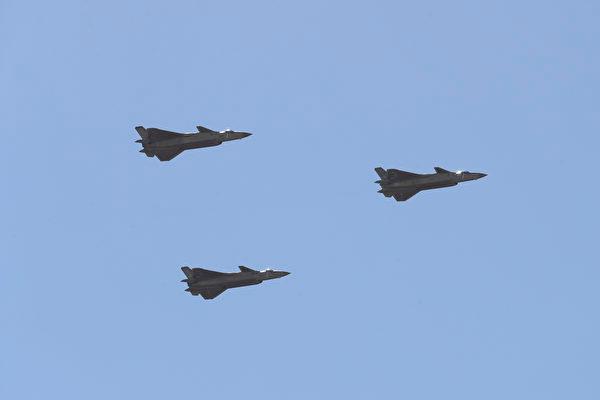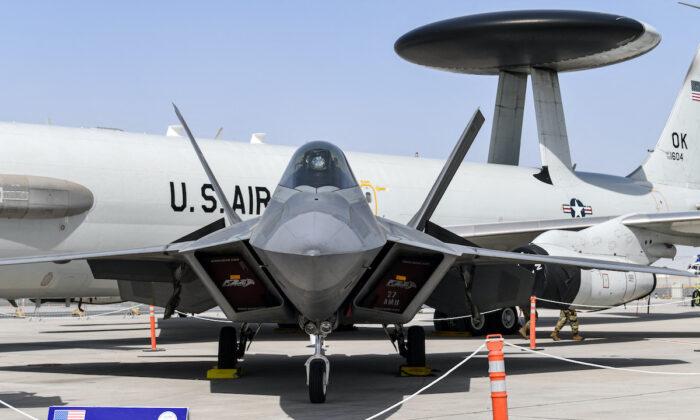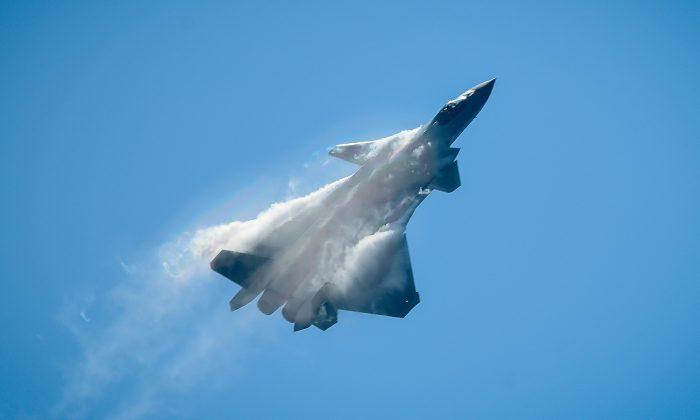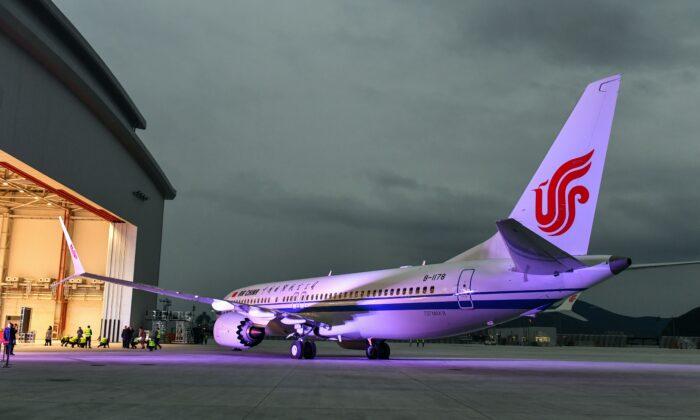To ensure the survival of its oppressive dictatorship, the Chinese Communist Party (CCP) is busy building the world’s most powerful military force—on Earth and in space—to achieve a new global hegemony under which it plans to set the rules that determine prosperity and security.
The CCP’s path to hegemony has always depended on its ability to manipulate the democracies and exploit their weaknesses and mistakes.
Since World War II, America’s ability to deter wars or win them has rested mainly on achieving air superiority over its enemies.
But that ability is under threat as the number of Lockheed Martin F-22A “Raptor” heavy fifth-generation air superiority fighters diminishes, while the number of China’s fifth-generation fighters is increasing, pointing to a period of strategic vulnerability for the United States in the mid-2020s.
By that time, the U.S. Air Force (USAF) will have only about 150 F-22A fighters with which to deter or fight a European war against Russia, an Asian war against China, or multiple and/or simultaneous wars that could include China, Russia, North Korea, and Iran.
This decline of America’s premier air superiority fighter, down from an initially envisioned program of 750 to 150 roughly, mirrors China’s rise as an airpower as it builds toward its ultimate ambition: to achieve global political-military hegemony to subordinate all other nations.
The F-22 emerged from the early-1980s Advanced Tactical Fighter effort to build a fifth-generation fighter to succeed in the best U.S. fourth-generation air superiority fighter, the McDonnell Douglas/Boeing F-15, and to outperform fourth-generation Soviet fighters like the Sukhoi Su-27/Su-30 and Mikoyan MiG-29 families.
An original goal to produce 750 fighters faced pressure from shifting post-Cold War and War on Terror priorities under successive administrations. George H.W. Bush decreased the planned fleet to 648; it declined to 339 under Bill Clinton, 227 under George W. Bush, and 187 under Barack Obama.
President Joe Biden’s most recent Defense Department budget proposal would retire 33 early productions of F-22A fighters, meaning only about 150 would be available to support five frontline fighter squadrons.
This latest reduction would occur at a time when a guarantee of allied air superiority is required for a range of scenarios. These include the following: preventing Russia from expanding its current war against Ukraine into the Baltic States or Poland; dissuading China from trying to exploit a distracted United States by attacking Taiwan; and deterring North Korea from staging a nuclear terrorist attack or a general attack against South Korea.
The Obama administration was not primarily responsible for reducing the F-22A fleet, but it does share responsibility for the final 2010 decision to terminate production at 187.
Hindsight is painful, but this decision was based on intelligence assessments that woefully underestimated China’s potential to develop and produce its own heavy fifth-generation air superiority fighter.
By 2009, there was much to suggest that China was working on a fifth-generation fighter, including cryptic Chinese disclosures at airshows, stealthy fighter wind tunnel models, and stealth paint.
But to justify its termination of F-22A production, the Obama administration asserted that China could not build a fifth-generation fighter threat to the United States by the mid-2020s.
In a major speech before the Economic Club of Chicago on July 16, 2009, then-Secretary of Defense Robert Gates stated the following:
“Consider that by 2020, the United States is projected to have nearly 2,500 manned combat aircraft of all kinds. Of those, nearly 1,100 will be the most advanced fifth-generation F-35s and F-22s. China, by contrast, is projected to have no fifth-generation aircraft by 2020. And by 2025, the gap only widens. The U.S. will have approximately 1,700 of the most advanced fifth-generation fighters versus a handful of comparable aircraft for the Chinese. Nonetheless, some have portrayed this scenario as a dire threat to America’s national security.”
According to the 2021 issue of the Military Balance by the International Institute of Strategic Studies, which covers military orders of battle for 2020, the United States had 165 F-22A and 367 Lockheed-Martin F-35 medium-weight aircraft, for a total of 532 fifth-generation fighters.
China, however, may have over 100 of its first fifth-generation fighter in 2022. The Chengdu Aircraft Corporation J-20 emerged toward the end of 2010 in a series of increasingly clear images. Its official first flight on Jan. 11, 2011, was turned into a propaganda strike, which was timed with the visit of Defense Secretary Gates.

China’s state-run tabloid Global Times reported on April 13 that the J-20 “has started to patrol the East China Sea and the South China Sea in routine training sessions.”
Over the last decade, the J-20 has undergone three major design modifications. A fourth will include new advanced thrust-vectoring WS-15 turbofans, enabling it to “supercruise” or fly supersonically for extended periods and achieve super-maneuverability—both long-dominant capabilities of the F-22A.
It appears that both the Bush and Obama administrations would also have been aware of a major Chinese victory: the theft of massive amounts of data on the F-22A and F-35 in a cyber espionage raid against Lockheed-Martin around 2007.
This would have allowed Chengdu to improve on the J-20’s stealth shaping, which does incorporate features of the F-22 and F-35.
By about 2013, a Chinese company was also marketing apparent copies of the F-35’s advanced electro-optical Distributed Aperture System (DAS), which, according to open sources, can detect a missile or aircraft up to 800 miles away. The J-20 is also equipped with a DAS.
Early this month, images emerged of four J-20s practicing aerial refueling from the new Xian Aircraft Corporation Y-20U large refueling aircraft. This means J-20 air superiority operations can be supported well into the “Second Island Chain” beyond Okinawa and Taiwan.
Chinese J-20, and fourth-generation fighters like the Shenyang J-16 and Chengdu J-10C, are armed with the estimated 124-mile-range PL-15 anti-aircraft missile, which the United States is trying to match with a new missile and may deploy later in 2022.
But that’s not all. Before 2030, the Shenyang Aircraft Corporation may be producing its “J-35” medium-weight twin-engine fifth-generation strike fighter, which will also equip the Chinese navy’s new conventional takeoff aircraft carrier.
By about 2025, assessed by Taiwan’s Defense Minister to be an optimal time for the PLA to invade Taiwan, the PLA Air Force may have over 150 J-20 fighters.
Should China’s attack be coordinated with Russian, North Korean, or Iranian military provocations, it is doubtful that the United States could dispatch 150 F-22s to Asia, while over 100 F-35A fighters will be in the fleets of Japan, South Korea, and Australia. The United States could deploy over 150 F-35s to Asia.
These numbers are perhaps too close for comfort, enough to tempt the PLA to attack. It is reasonable to conclude that another 150 F-22A fighters would have provided a much greater margin of deterrence.





